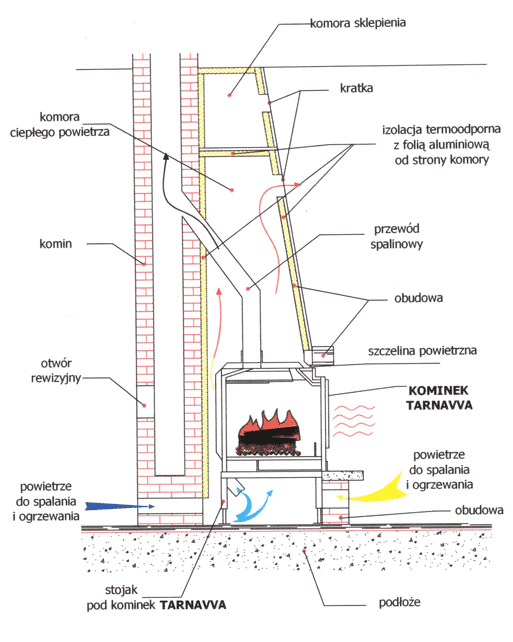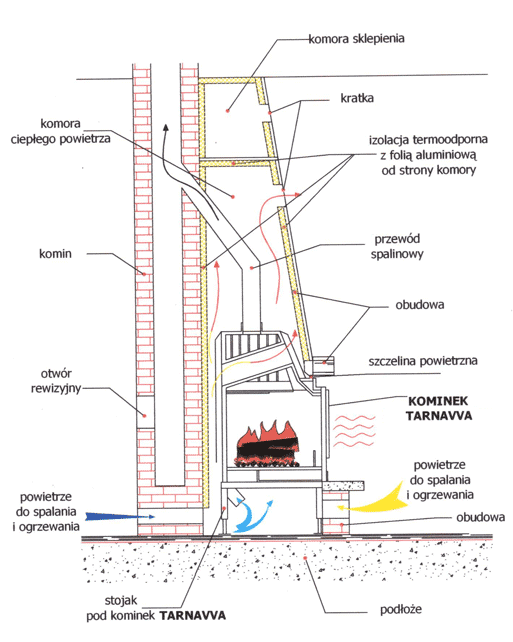Fireplace installation instructions
- After placing all elements of fireplace insert the next step is to choose the right place to insert the fireplace.
- Before inserting the fireplace in the place suited for it, we have to make sure that the ground has the right tensile strength. It should be made out of non-flammable materials (min 15 cm thickness) for example brick, concrete, fire-proof ceramic plates. If the ground doesn’t meet the carrying capacity requirements or you are not sure of it, it is important that you call experts with building permission, who will make a professional analysis and suggest an appropriate design solution, by for example pointing another place which meets the requirements or point a method of weight repartition in larger space.
- The fireplace is situated on specially installed stand made by our company, which height you can adjust from 150 mm to 330 mm. The stand is a frame construction, which enables air flow and automatic cooling of the fireplace insert. The Fireplace insert can be placed on the brick-ferro-concrete chimney breast, in which you should keep 500 cm2 hole, situated right under the chimney, in order to secure the air flow required for cooling the fireplace.
- Above the fireplace there should be an air box min. 1 m height, from which gathered combusted air will be drawn outside – into the room – through a blower system or vent strips situated on the air box casing.
- Tarnavva inserts can be installed and operated in the casing, but in this case certain space between flammable materials and flammable building materials should be kept (see point 13, subsection 8).
- In front of the fireplace, especially on the ground, a minimum safety space should be kept, which is 100 cm, made of non-flammable materials (ceramic tiles, terracotta, metal plate) in order to secure the floor from possible glowing embers falling out of the firebox.
- In case you do not have the possibility of keeping a safe space, and there are flammable materials next to the fireplace, you should contact a company which specialises in insulation, which will recommend or make a thermal resistant insulation.
Material copyrighted! Publication in whole or in part only with the consent of the author.
Insulation
INSULATION AND DISTANCE OF FIREPLACE FROM THE WALLS
In the case of the fireplace being cased or built in, you should pay attention to ceramic walls of the building being in contact with fireplace insert. They should be equipped with thermal insulationofmineral wool-sided padwith a minimum thickness50 mm, minimumtemperature resistance of750 °C, density110kg/m3andthermal conductivity0.038[W / mK], because long heat effect on the walls causes cracking. It is forbidden to connect the fireplace with the case because during the fire the temperature rises, which causes the fireplace to widen. In case the walls of the room in which the fireplace is installed are made of flammable materials, the case should be made out of ceramic materials, 1000’C temperature resistant, min 10 cm thickness, and contain glass fibre with the same parameters.
Air gap in the case, between external outline of the fireplace and internal edge of the case should be:
- with gravity heating – 100mm (for sides, back); for bottom 350mm, for top 1000mm,
- with forced air heating – 50mm (for sides, back); for bottom and top – as above.
Material copyrighted! Publication in whole or in part only with the consent of the author.
Connecting fireplace to the chimney
The fireplace insert should be connected to the chimney, and its chimney draught with the nominal heat input should be at 12Pa. If the chimney has a high chimney draught you can install a throttling device in it or install device regulating the draught on the connection vent. The heater should not be connected to the chimney with other fireplaces.
Flues should be constructed in accordance with applicable building standards and regulations.
– The Journal of Laws No. 75 from 2002, item 690&140, regulation 1 and 2 as well as &145 regulation 1.
Connected throttling devices or devices regulating the chimney draught should be constructed from materials with proper certificates and approved for use in building.
Connection elements should be installed in a way to avoid condensation building up when burning damp wood. Combustion of damp wood will cause soot building up in the fireplace, connector and chimney.
Material copyrighted! Publication in whole or in part only with the consent of the author.
Pictorial view of TARNAVVA fireplace insert casing installation

















